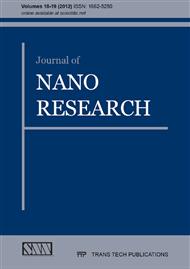[1]
R. E. Franklin, Proc. Roy. Soc. A 209 (1951) 196.
Google Scholar
[2]
G. M. Jenkins and K. Kawamura, Polymeric carbons—carbon fibre, glass and char, Cambridge, (1976).
Google Scholar
[3]
P. J. F. Harris, Int. Mater. Rev. 42 (1997) 206.
Google Scholar
[4]
P. J. F. Harris, Philosophical Magazine 84 (2004) 3159.
Google Scholar
[5]
C. E. M. de Oliveira, M. M. G. de Carvalho, C. A. C. Mendonça, C. R. Miskys, G. M. Guadalupi, M. Battagliarin and M. I. M. S. Bueno, J. of Crystal Growth 186 (1998) 487.
DOI: 10.1016/s0022-0248(97)00815-4
Google Scholar
[6]
M. Kuhnke, T. Lippert, E. Ortelli, G. G. Scherer, and A. Wokaun, Thin Solid Films 453-454 (2004) 36.
DOI: 10.1016/j.tsf.2003.11.156
Google Scholar
[7]
M. Takahashi, K. Sugimoto, and R. Maeda, Jpn. J. Appl. Phys. 44 (2005) 5600.
Google Scholar
[8]
S. W. Youn, M. Takahashi, H. Goto, and R. Maeda, Microelectron. Eng. 83 (2006) 2482.
Google Scholar
[9]
S. W. Youn , M. Takahashi , H. Goto , and R. Maeda, J. Micromech. Microeng. 16 (2006) 2576.
Google Scholar
[10]
S. W. Youn , M. Takahashi , H. Goto , T. Kobayashi and R. Maeda, J. Micromech. Microeng. 16 (2006) 1277.
Google Scholar
[11]
S. W. Youn, A. Ueno, M. Takahashi and R. Maeda, J. Micromech. Microeng. 19 (2009) 125010.
Google Scholar
[12]
M. J. Vasile, R. Nassar, J. Xie and H. Guo, Micron 30 (1999) 235.
Google Scholar
[13]
AA Tseng, J. Micromech. Microeng. 14 (2004) R15.
Google Scholar
[14]
Q. Hu and W. O'Neill, Appl. Surf. Sci. 256 (2010) 5952.
Google Scholar
[15]
Q. Hu and W. O'Neill, J. Nanosci. Nanotechno., doi: 10. 1166/jnn. 2011. 3773, 11 (2011) (in press).
Google Scholar
[16]
Hochtemperatur Werkstoffe GmbH: http: /www. htw-germany. com/ technology . php5?lang=en&nav0=2.
Google Scholar
[17]
T. Ishitani and H. Kaga, J. Electron. Microsc. 44 (1995) 331.
Google Scholar
[18]
Y. M. Park, D. -S. Ko, K. -W. Yi, I. Petrov and Y. -W. Kim, Ultramicroscopy 107 (2007) 663.
Google Scholar
[19]
N. Shukla, S. K. Tripathi, A. Banerjee, A. S. V. Ramana, N. S. Rajput, V. N. Kulkarni, Appl. Surf. Sci. 256 (2009) 475.
Google Scholar
[20]
D. R. Lide, Handbook of Chemistry and Physics, 89th ed., CRC, (2008).
Google Scholar
[21]
J. V. Naidich and J. N. Chuvashov, J. Mater. Sci. 18 (1983) (2071).
Google Scholar
[22]
M. Tamura, Mater. Sci. Rep. 6 (1991) 141.
Google Scholar
[23]
W. F. van Dorp and C. W. Hagen, J. Appl. Phys. 104 (2008) 081301.
Google Scholar
[24]
M. Mikkelsen, E. Hilner, J. N. Andersen, S. Ghatnekar-Nilsson, L. Montelius and A. A. Zakharov, Nanotechnology 20 (2009) 325304.
DOI: 10.1088/0957-4484/20/32/325304
Google Scholar
[25]
J. P. Biersack, L. G. Haggman, Nucl. Instrum. Method 174 (1980) 257.
Google Scholar
[26]
M. Shibata, S. S. Stoyanov and M. Ichikawa, Phys. Rev. B 59 (1999) 10289.
Google Scholar
[27]
D. Z. Xie, B. K. A. Ngoi, W. Zhou and Y. Q. Fu, Appli. Surf. Sci. 227 (2004) 250.
Google Scholar
[28]
R. Batabyal, S. Patra, A. Roy, S. Roy, L. Bischoff and B. N. Dev, Appli. Surf. Sci. 256 (2009) 536.
Google Scholar
[29]
M. Zinke-Allmang, L. C. Feldman and M. H. Grabow, Surf. Sci. Rep. 16 (1992) 377.
Google Scholar
[30]
M. Zinke-Allmang, Thin Solid Films 346 (1999) 1.
Google Scholar
[31]
Q. Hu, M. Zinke-Allmang and I. V. Mitchell, Jpn. J. Appl. Phys. 40 (2001) 6029.
Google Scholar
[32]
Q. Hu and M. Zinke-Allmang, J. Vac. Sci. Technol. A 20 (2002) 1023.
Google Scholar
[33]
J. H. Wu, W. Ye, B. L. Cardozo, D. Saltzman, K. Sun, J. F. Mansfield and R. S. Goldman, Appl. Phys. Lett. 95 (2009) 153107.
Google Scholar
[34]
K. L. Carleton and S. R. Leone, J. Vac. Sci. Technol. B 5 (1987) 1141.
Google Scholar
[35]
B. Bourguignon, K. L. Carleton, and S. R. Leone, Surf. Sci. 204 (1988) 455.
Google Scholar
[36]
A. Portavoce, R. Hull, M. C. Reuter and F. M. Ross, Phys. Rev. B 76 (2007) 235301.
Google Scholar
[37]
Q. Hu and P. Chopra, Optics and Lasers in Engineering 49 (2011) 498.
Google Scholar


